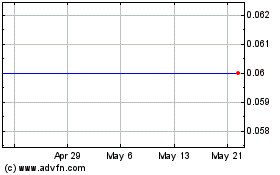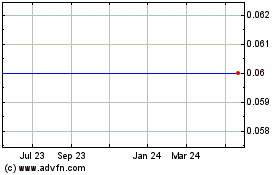Gespeg Brings Update on Lac Arsenault Project
November 03 2020 - 9:43AM

GESPEG RESOURCES LTD.
(TSX-V:GCR) (the “
Company” or
“Gespeg”) , is
pleased to provide an update of the exploration work on its 100%
owned Lac Arsenault project, located in the center of the Gaspé
Peninsula, Quebec. Gespeg is currently proceeding with exploration,
trenching and geophysical work following the completion of the
structural geology report by Mr. Jean-Philippe Desrochers P.Geo,
Ph.D.. (see complete report). The soil samples collected in the
field have been sent for assay, and Gespeg will report the results
when received.
Sylvain Laberge President & CEO
“Mr. Desrochers is a very well-regarded geological
professional who has worked on many well known projects in Quebec
and around the world. His knowledge and regional experience have
played a significant role in increasing our understanding of the
vein systems at Lac Arsenault and are bringing a new vision and
approach for new discoveries on the Lac Arsenault gold
project”.
The program underway at Lac Arsenault included
structural mapping on the Mersereau, Marleau, L4W, and Baker
trenches, which was completed between September 18 and September
24, 2020. Approximately 150 structural measurements were collected.
The contour of the deformation corridors and the veins was also
surveyed, using a precision GPS (10 cm). (see Lac Arsenault
map)(2005 data report)
These newly excavated and cleaned trenches on
the Lac Arsenault gold property provided a unique opportunity to
identify 4 types of quartz veins that are concentrated along
several deformation corridors.
During the mapping program, specific attention
was directed to the different types of quartz veins in order to
determine their characteristics, geometries, relative chronology,
as well as their metal contents using the results of analysis of
previous channel samples.
The observations indicate that the zones
enriched in gold form corridors which can contain shear veins and
extension veins that have been variably folded, until they form
isoclinal folds. When the extension veins are folded and
sufficiently abundant, they generated panels running parallel to
the shear veins.
The 4 quartz veins type identified are as
follows:
- Type 1 veins are
laminated veins (shear veins) rich in sulphides (pyrite, galena,
sphalerite and some arsenopyrite and chalcopyrite) which contain
high levels of gold, silver, lead, and sometimes zinc. Despite
being relatively thin in the trenches, they represent veins that
have a potential for continuity.
- Type
2 veins are tension veins rich in sulphides which were
formed contemporaneously with type 1 veins during sinistral shear.
They have been developed at a high angle with respect to the shears
but have been folded in an isoclinal way, meaning their envelope is
subparallel to the shears. They appear to contain high levels of
metals like type 1 veins. When present in large quantities and
tightly folded, these veins also have interesting potential.
- Type
3 veins are tension veins generally poorer in sulphides
than type 1 and 2 veins. When less deformed, they have a comb
texture with quartz crystals at a high angle to the contacts of the
veins. These veins are generally low grade, but some veins returned
up to 8 g/t Au. These veins were generated at a high angle to the
shear and were subsequently variably folded during continuous
deformation.
- Type
4 veins are also tension veins, low in sulphides and
possessing a comb texture with quartz crystals perpendicular to the
contacts of the veins. These veins are poor in metals and are
weakly undulating.
The sinistral shear movement that was previously
interpreted was confirmed during the 2020 mapping for the shears
that are associated with the vein corridors. Evidence of this
sinistral movement has been identified on the Mersereau, Baker and
L4W trenches. These fragile-ductile zones seem to correspond to
secondary structures of the Grand Pabos fault, which is an
important dextral strike-slip fault, which is known to be gold
bearing, and cross-cuts the entire Gaspe Peninsula.
The detailed mapping allows the development of a
conceptual model of the formation and deformation of quartz veins
on the Lac Arsenault gold project:
Conceptual model of the formation and
deformation of quartz
veins at the Lac Arsenault gold
project
https://www.globenewswire.com/NewsRoom/AttachmentNg/6fe2bdcc-d0e2-4b8f-a2cb-5e4ab5792596
About Lac Arsenault
Project: The Gespeg Resources Ltd 100%
owned Lac Arsenault property is located 45 kilometres to the
northeast of the town of Bonaventure, on the south coast of the
Gaspé Peninsula. The property consists of 39 claims in the central
part of NTS sheet 22A/06, in Weir and Honorat townships.
The property is located along the Grand Pabos
fault, in the south-eastern part of the Gaspé Peninsula. Its
immediate environment reveals a series of superficial geophysical
anomalies, drained by the Grand Pabos fault from a mass buried at
great depth. The research, carried out in 2014 by the Consorem
(regional exploration guide for cu, au, mo (pb, zn) porphyries and
skarns in Gaspesie) , concludes that the
intersection of the geochemical targets (favorable rocks) and of
the geophysical analysis with the analysis of the streams sediments
identify several very favorable zones porphyry type (skarns)
deposits and the “Reduced Intrusion-Related” type Gold Systems
”(RIRGS) along the Grand Pabos fault. The mineralization observed
and interpreted as gold veins placed in deformation corridors
secondary to the Grand Pabos fault, could originate from the
environment of these types of deposits.
About Gespeg
Resources Inc.: Gespeg is an exploration company
with a focus in strategic and energetic metals and underexplored
regions “Gaspé, Chibougamau Québec”. With a dedicated management
team, the Company’s goal is to create shareholder value through the
discovery of new deposits.
Bernard-Olivier Martel, P. Geo, the Company's
Director of Exploration, is a qualified person (as such term is
defined in National Instrument 43-101 - Standards of Disclosure for
Mineral Projects) and has reviewed and approved the technical
disclosure contained in this news release.
GESPEG RESOURCES
LTD.
(signed) “Sylvain
Laberge”
Sylvain Laberge President and
CEO
514.702.9841slaberge@gespegcopper.com
Some of the statements contained in this press
release are forward-looking statements and information within the
meaning of applicable securities laws. Forward-looking statements
and information can be identified by the use of words such as
“expects”, “intends”, “is expected”, “potential”, “suggests” or
variations of such words or phrases, or statements that certain
actions, events or results “may”, “could”, “should”, “would”,
“might” or “will” be taken, occur or be achieved. Forward-looking
statements and information are not historical facts and are subject
to a number of risks and uncertainties beyond the Company’s
control. Actual results and developments are likely to differ, and
may differ materially, from those expressed or implied by the
forward-looking statements contained in this news release.
Accordingly, readers should not place undue reliance on
forward-looking statements. The Company undertakes no obligation to
update publicly or otherwise revise any forward-looking statements,
except as may be required by law.
Neither TSX Venture Exchange nor its
Regulations Services Provider (as that term is defined in policies
of the TSX Venture Exchange) accepts responsibility for the
adequacy or accuracy of this release.
Gespeg Resources (TSXV:GCR)
Historical Stock Chart
From Oct 2024 to Nov 2024

Gespeg Resources (TSXV:GCR)
Historical Stock Chart
From Nov 2023 to Nov 2024
